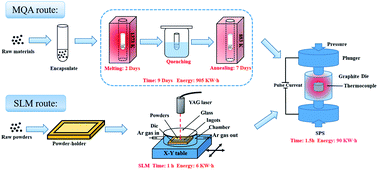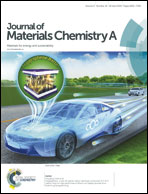Scanning laser melting for rapid and massive fabrication of filled skutterudites with high thermoelectric performance
Abstract
Skutterudite-based thermoelectric materials have great potential for use in waste heat recovery, but the conventional melting–quench–annealing process is not suitable for large-scale fabrication. In this study, we developed a rapid fabrication technique that combines scanning laser melting and spark plasma sintering to synthesize bulk n-type and p-type filled skutterudites. The kinetics process and microstructure evolution during the scanning laser melting and annealing were systematically investigated. Due to fast solidification in scanning laser melting, the peritectic segregation size of precursor resultants is confined to several microns, which leads to great shortening of the fabrication period of filled skutterudites. The as-synthesized n-type and p-type filled skutterudites achieve excellent dimensionless figures of merit: ZT ∼ 1.23 at 850 K for Yb0.4Co4Sb12.1; ZT ∼ 1.09 at 700 K for In0.5Co4Sb12.1; ZT ∼ 0.79 at 750 K for Ce0.95Fe3CoSb12.1, which are among the highest values of single filled skutterudites. The shortened processing period and enhanced thermoelectric performance make this novel synthesis method suitable for industrial-level large-scale fabrication of skutterudite-based thermoelectric materials.

- This article is part of the themed collection: 2018 Journal of Materials Chemistry A HOT Papers


 Please wait while we load your content...
Please wait while we load your content...